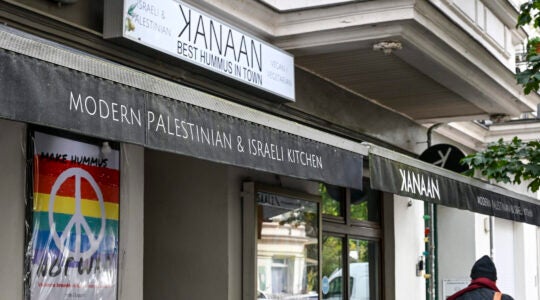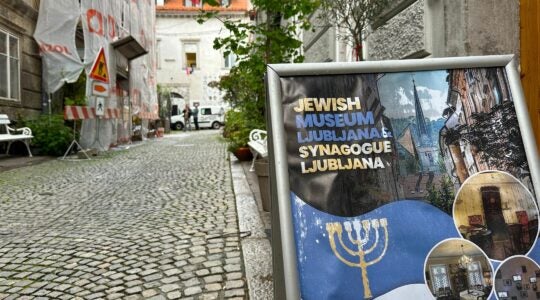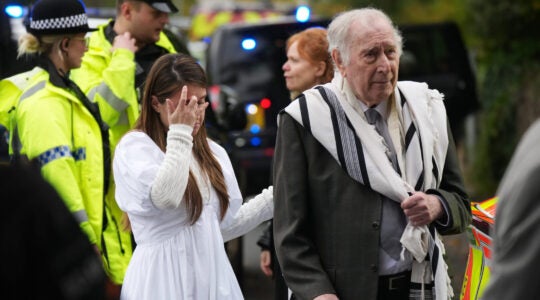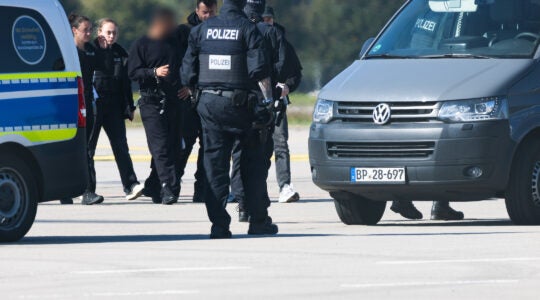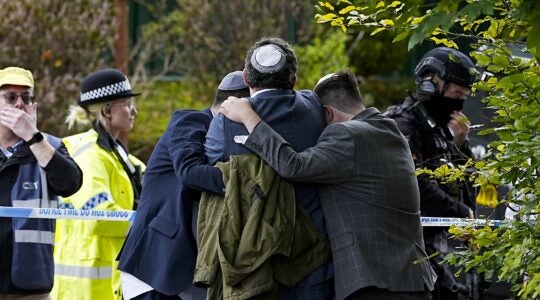
Milos Zak, who spearheaded the Lost City project for the Slovak-Israel Chamber of Commerce, holds open his guidebook to show drawings of a synagogue that stood until the entire Jewish quarter of Bratislava was demolished in the late 1960s. (Ruth Ellen Gruber)

A replica of an ornate twin-towered synagogue in Bratislava was erected in the place where it stood until it and the entire Jewish quarter of the city were destroyed by communist authorities in the late 1960s to build a new bridge and highway. (Ruth Ellen Gruber)
KRAKOW, Poland (JTA) — Thanks to a new iTunes app, new tourist routes and a towering replica of a destroyed synagogue, two “lost” Jewish cities in Europe are back on the map.
One is the historic Jewish quarter of Bratislava, the Slovak capital, which survived World War II only to be demolished by communist authorities in the late 1960s. The other is Oshpitzin — the prewar Yiddish name for Oswiecim, the once mainly Jewish town in southern Poland where the Auschwitz death camp was built.
The two projects differ in scope and structure, but their goals are the same: to restore awareness of the forgotten Jewish past in an effort to foster a better understanding of the present — for tourists and the locals.
Oshpitzin uses a new iPad/iPhone application to augment a website, map and book, while the Lost City project in Bratislava focuses on a tourist itinerary and the temporary reconstruction of an ornate, Moorish-style synagogue in the city’s picturesque Old Town.
The Oshpitzin app “pioneers the use of the most advanced technology for the commemoration of a destroyed Jewish community in east-central Europe,” said Tomasz Kuncewicz, the director of the Auschwitz Jewish Center, a prayer and study center founded in Oswiecim in 2000 that produced the Oshpitzin project.
The app, launched this month, is free from iTunes and soon will be available for Android. It is the latest part of a three-pronged Oshpitzin project that already includes a website and book published last year.
Centered on an interactive map that can guide visitors through the anonymous spaces of today’s city, the app includes videos, testimonies of survivors, audio-description and 3-D models of the destroyed Great Synagogue.
The aim is to hammer home the fact that while Auschwitz, built on Oswiecim’s outskirts, was a mass death factory for more than a million individuals, the Shoah also annihilated a deeply rooted Jewish lifestyle and culture in Europe that was exemplified by Oswiecim itself.
Before the Holocaust, Oswiecim — Oshpitzin — was a bustling, majority Jewish town with synagogues, study houses, clubs, schools, shops and other businesses. Jews had lived there for centuries and were active in all spheres of life; in the 1930s there was even a Jewish deputy mayor.
Only a few physical traces remain, including the Jewish cemetery and one small synagogue, now part of the Auschwitz Jewish Center complex.
“The Oshpitzin project puts everything on the Oswiecim map,” Kuncewicz told JTA. “And the app opens a totally new way of educating about Jewish history and the destruction caused by the Holocaust. It’s a way that today is the most appealing to the new generations.”
In Bratislava, the Lost City project uses somewhat different methods to tell a similar story.
“We want to bring back historical memory,” said Slovak Jewish businessman Milos Ziak, who spearheaded the project.
Sponsored by the Slovak-Israel Chamber of Commerce, the Lost City project entails a tourist route, complete with guidebook, to Bratislava’s crowded Jewish quarter, which stood for centuries beneath the city’s hilltop castle until communist authorities razed it in 1968-69 to build a highway and bridge across the Danube.
“It’s an itinerary through a nonexistent city,” Ziak told JTA. “And people sometimes forget it was the communists who tore down the Jewish quarter.”
For the launch in late June, Ziak led a group of Slovak officials, diplomats, businesspeople and Jewish representatives on a walking tour of the places where Jewish sites had once stood — synagogues, schools, a prominent yeshiva, houses.
The tour followed Ziak’s guidebook, called “Demolished Jewish Bratislava,” which includes pictures of both the vanished sites and the demolition. (Footage of the Jewish quarter before and during its destruction can be seen on YouTube.)
The tour wound up at the plaza where a grand, twin-towered synagogue once stood next to the city’s cathedral and at the very edge of the new highway.
Here a ceremony inaugurated the centerpiece of the Lost City project — a towering, two-thirds scale replica of the ornate, Moorish-style synagogue. Constructed of scaffolding and canvas, the orange-striped mock-up will stand on the spot for three months.
Built in 1894, the synagogue, which served the Neologue, or moderate, Reform congregation was a proud symbol of the Bratislava Jewish community. Its destruction little more than two decades after most of Bratislava’s 15,000 Jews were murdered in the Shoah symbolized communist-era suppression of Jewish life.
Indeed, right after the fall of communism in 1989, activists painted a big picture of it on the pavement where it had stood, with an angry scrawl alongside: “Here there was once a synagogue!”
About 600 Jews live in Bratislava today, and a few days before the Lost City launch, the city’s Jewish community unveiled an important project of its own — a Jewish community museum in the women’s gallery of the Heydukova Street Synagogue, the only synagogue in the city to have survived the Holocaust and communism. It is a striking, cubist-style building from the 1920s that is still used by the congregation.
“The museum tells a story, our story, that dates back centuries,” Maros Borsky, the Jewish community vice president who conceived and curated the museum, told JTA.
The new museum’s displays of Judaica, documents, photographs and other artifacts illustrate Jewish life before, during and after the Shoah. They include a portrait of the Chatam Sofer (Rabbi Moshe Sofer), an influential 19th-century rabbi whose tomb in Bratislava remains a site of pilgrimage.
In another effort to restore historic memory, the Chatam Sofer, who died in 1839, has been embraced recently by the city as one of its key historic personalities. In June, just ahead of the museum opening and Lost City launch, the Slovak mint issued a special commemorative coin to mark the 250th anniversary of his birth. It bears a portrait of the rabbi with a menorah and Torah scroll on one side, and a panorama of Bratislava’s now-lost Jewish quarter on the other.
JTA has documented Jewish history in real-time for over a century. Keep our journalism strong by joining us in supporting independent, award-winning reporting.

